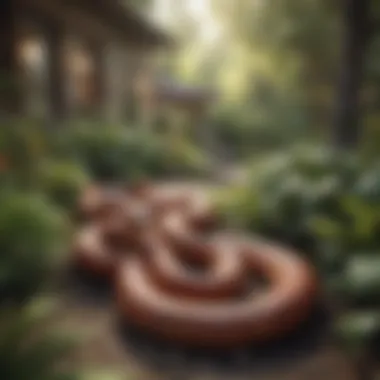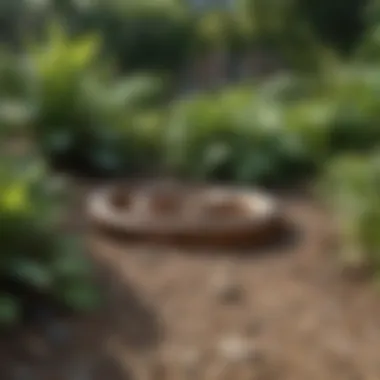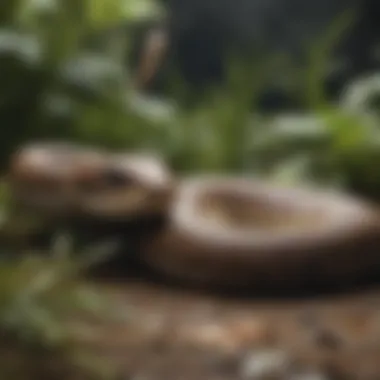Effective Strategies for Keeping Snakes Out of Your Yard


Intro
Managing snakes in residential areas is a concern for many homeowners. Snakes may be present due to the availability of food, shelter, or suitable habitats. Understanding these factors is critical for developing effective prevention strategies. This article will guide you through various methods to deter snakes from entering your yard, emphasizing practical measures, landscaping techniques, and safe interaction guidelines.
Design Inspiration
One of the best ways to make your yard less appealing to snakes is through thoughtful design and landscaping. By choosing specific plants and arranging your outdoor space wisely, you can create an environment that is not hospitable to snakes.
Landscaping Techniques
Landscaping can play a crucial role in preventing snake encounters. Here are some useful strategies:
- Clearing Debris: Keep your yard free from piles of leaves, wood, and any other material that can serve as hiding spots for snakes.
- Incorporating Ground Covers: Use prickly or thorny ground covers that discourage snakes from entering your property. Plants like barberry or holly can be effective.
- Setting Boundaries: Place barriers such as wooden fences around the perimeter of your yard. Ensure these fences extend underground to prevent snakes from burrowing underneath.
Maintaining a well-manicured yard sends a clear message to snakes that your property is not a suitable habitat.
Plant Selection and Care
Certain plants can act as deterrents to snakes. Here is a list of plants that may help keep snakes away:
- Lavender
- Marigolds
- Onion
- Garlic
- Plants with strong scents
Proper care of these plants is important. Regular watering and maintenance promote healthy growth, making them more effective as natural deterrents.
Tip: Monitor your yard for signs of snake activity. Observing patterns can help you adjust your strategies regularly, ensuring ongoing effectiveness.
Environmental Considerations
It is essential to consider the environmental conditions of your yard. Snakes thrive in areas with ample moisture and shelter. Thus, you should assess the following:
- Water Sources: Remove standing water or minimize water features that might attract prey for snakes, such as amphibians and rodents.
- Natural Shade: Trim shrubs and overhanging branches that may provide cool, sheltered spots suitable for snakes.
- Pest Control: Minimize food sources. Controlling rodent populations through proper trash management and securing food sources can help reduce snake attraction.
Addressing these environmental aspects can significantly lower the chance of snakes making your yard their home.
Epilogue
Understanding Snake Behavior
Understanding snake behavior is crucial for homeowners who wish to prevent these reptiles from entering their yards. Snakes play ecological roles, yet their presence in residential areas can be unsettling. Knowledge of why snakes invade yards provides a proactive foundation for effective preventative measures.
Why Snakes Enter Yards
Snakes are instinctively drawn to environments that provide food, shelter, and moisture. Common reasons include:
- Food Sources: Many snakes prey on rodents. If your yard has a high rodent population, it may attract these snakes. Keeping the area free from food sources can deter them.
- Hiding Spots: Dense vegetation, wood piles, and debris create excellent hiding spots. Snakes love to feel concealed and secure.
- Breeding Grounds: Yards with adequate moisture and specific plants can serve as breeding habitats. Ensuring that your yard is less appealing in this regard is essential.
By analyzing these factors, homeowners can take steps to create an environment less inviting to snakes.
Identifying Common Snake Species
Recognizing common snake species around your home can significantly aid in prevention efforts. Several species, such as the Eastern Garter snake or the Copperhead, have distinct behaviors and preferences:
- Eastern Garter Snake: Usually harmless, they thrive in gardens, seeking small insects and frogs.
- Copperhead: A venomous snake, often seen in wooded areas. Its presence is notable due to its ability to camouflage among leaves.
Identification helps homeowners respond appropriately. If a non-venomous snake is found, it may be better to leave it alone, whilst identifying a venomous snake can necessitate immediate action.
Seasonal Trends in Snake Activity


Snakes display varying levels of activity depending on the season. In the spring, they emerge from hibernation, seeking warmth and food. Summer often sees them active, while autumn can mean increased movement in preparation for winter.
- Spring: Increase in sightings as snakes awaken.
- Summer: Peak activity, commonly found in gardens and sunny spots.
- Autumn: Snakes may be seen searching for food before the cold sets in.
Understanding these trends allows homeowners to be vigilant during peak times, making it easier to implement preventative actions effectively.
Knowledge of snake behavior and activity patterns can greatly enhance your ability to maintain a safe yard.
By understanding why snakes enter yards, the common species found in specific areas, and their seasonal activity patterns, homeowners can take informed steps to keep their living spaces snake-free.
Yard Assessment and Modification
Yard assessment and modification are crucial factors in deterring snakes from entering your yard. A well-maintained outdoor space serves not only aesthetic purposes but also creates a less inviting environment for snakes. Understanding how your yard’s layout, vegetation, and overall condition can attract or repel snakes allows homeowners to take an informed approach in managing their landscape. The benefits of an effective assessment include reduced snake visibility, improved safety for children and pets, and enhanced yard usability for family activities.
Conducting a Yard Inspection
To begin, a thorough yard inspection is necessary. This involves evaluating all potential snake habitats within your property. Look for areas with excessive grass growth, piles of debris, or any places that could provide shelter. Inspect rock formations, wood piles, or any ornamental structures as snakes often hide in these spots. Be mindful of places where moisture gathers, as snakes are usually drawn to water sources.
During this inspection, also consider the proximity of your yard to natural habitats, such as woods or fields. If your yard is adjacent to these areas, increasing precautions might be necessary. Document any specific findings, as this will help in creating a targeted plan for modification.
Eliminating Hiding Spots
After completing the inspection, eliminating hiding spots is the next step. Snakes thrive in environments that offer protection and cover. Common hiding spots can include:
- Tall grass and dense shrubs
- Piles of leaves or debris
- Wood stacks that have not been used for some time
- Spaces under decks or porches
To reduce these areas, homeowners should regularly clear debris and cut back overgrown vegetation. This creates an open space that is less appealing to snakes. If certain plants seem particularly attractive to snakes, consider replacing them with more open and less dense landscaping. Doing this not only helps in snake prevention but also enhances the overall aesthetic appeal of the yard.
Trimming Vegetation and Grass
Maintaining trimmed vegetation and grass is essential in your yard management strategy. Keeping grass cut short minimizes the likelihood of snakes hiding. Aim for a maintained height of 2 to 3 inches, as this level of upkeep makes it harder for snakes to conceal themselves.
In addition to grass, shrubs and trees should also be pruned regularly. Ensuring that limbs do not extend close to the ground prevents shelter for snakes. The best approach is to create a clear separation between lower plant leaves and the ground.
Regular landscaping not only provides visual appeal but also significantly reduces the risk of snake encounters. Incorporating these practices into routine maintenance fosters a less inviting habitat for snakes and promotes safer outdoor living.
Habitat Management Techniques
Habitat management techniques play a crucial role in preventing snakes from invading residential yards. They focus on modifying the environment to make it less appealing or accessible for snakes. This can lead to a significant decrease in snake sightings. By understanding the habits of snakes, homeowners can implement effective measures to manage their yards strategically.
Managing Rodent Populations
One of the key factors that attract snakes to your property is the presence of rodents. Rodents such as mice and rats are a primary food source for many snake species. Managing rodent populations can effectively reduce this attractive prey. Homeowners can take steps to minimize rodent habitats, such as:
- Storing food in sealed containers to avoid attracting rodents.
- Sealing entry points to buildings and sheds, preventing rodents from accessing shelter.
- Implementing traps or baits carefully, focusing on areas with known rodent activity.
By controlling the rodent population, snakes will have less incentive to enter your yard in search of food.
Water Source Considerations
Water sources can also draw snakes into your yard. Snakes are often found near water, looking for both hydration and prey. Homeowners should consider the following to reduce these water sources:
- Remove standing water from gutters, buckets, or old tires where water may collect.
- Maintain outdoor water features such as ponds or fountains. Consider using pumps to circulate the water or keep it at a minimum.
- Redirect drainage to prevent pooling in certain areas of the yard.
By minimizing water access, the yard will become less inviting for snakes returning to a nearby source.
Creating Physical Barriers


Creating physical barriers is a proactive approach in habitat management. The use of barriers can effectively deter snakes from entering yard spaces. Some aspects to consider when creating physical barriers include:
- Installing snake fencing, made of strong materials like welded wire, designed to keep snakes out. Typically, fences should be buried a few inches below ground to prevent snakes from burrowing underneath.
- Using rocks or gravel to create barriers around the base of fences, making it harder for snakes to cross over.
- Maintaining regular inspections of barriers to ensure effectiveness, looking for gaps or wear.
With well-constructed barriers, homeowners can create a reliable defense against snake entry into their yards.
By managing the habitat effectively, homeowners can significantly reduce the likelihood of snakes entering their yards. Understanding the environment's influence on snake behavior can lead to a snake-free outdoor space.
Practical Deterrents
Practical deterrents are crucial for homeowners who want to keep their outdoor spaces safe from snakes. These methods offer proactive rather than reactive measures, reducing the chances of unexpected encounters with these reptiles. By employing practical deterrents, one can create an environment that lessens the attraction for snakes, making yards more hostile to them without harming the animals.
Using Natural Repellents
Natural repellents can be an effective first line of defense against snakes. Many homeowners prefer these options as they are environmentally friendly and non-toxic. Common natural repellents include essential oils such as clove oil, cinnamon oil, and cedar oil. Applying such oils around the perimeter of the yard can create an unpleasant scent for snakes. Additionally, certain plants like marigolds and lemongrass are thought to repel snakes due to their aromas.
To maximize their effectiveness, natural repellents must be reapplied frequently, especially after rain.
Employing Commercial Snake Repellents
Commercial snake repellents are readily available in stores and can offer a more potent deterrent. These products are specifically formulated to deter snakes and often contain ingredients that irritate their senses. The effectiveness of these repellents can vary based on the formulation and the local snake species. Objectively, one should evaluate options like snake away products that are designed for outdoor application. Regular use is important to maintain efficacy, and following the manufacturer’s instructions is essential to ensure safety for children and pets.
Installing Snake Fencing
Installing snake fencing is an effective method to provide a physical barrier to snakes. This fencing should be at least 3 feet tall and made of materials like wire mesh that have small openings. The bottom of the fencing should be buried about 6 inches deep to prevent snakes from burrowing underneath. It's critical to ensure that the fencing does not have gaps, as many snakes can squeeze through surprisingly small spaces.
Regular maintenance of the fencing is also necessary. Overgrown vegetation or debris against the fence line can create hiding spots for snakes.
"Creating physical barriers, such as snake fencing, not only enhances safety but also provides peace of mind for homeowners."
In summary, employing these practical deterrents is a strategic approach for homeowners aiming to mitigate potential snake encounters in their yards. Each method offers unique benefits and can be adapted to fit individual circumstances, contributing to a more snake-free outdoor environment.
Maintaining a Snake-Free Yard
Keeping a yard free from snakes is crucial for homeowners who want to enjoy their outdoor spaces without worry. A clean and well-maintained yard not only discourages snake habitation but also enhances the overall aesthetic and functionality of the property. By implementing regular maintenance practices, you can significantly reduce the chances of an unwelcome snake encounter. This section will explore two key components of maintaining a snake-free environment: routine yard maintenance and seasonal considerations.
Routine Yard Maintenance
Routine yard maintenance is the foundation of keeping snakes at bay. Regularly inspecting your property helps identify potential problem areas before they turn into snake habitats. This includes removing debris, such as fallen branches and leaves, where snakes may find shelter. Keeping your lawn mowed ensures that grass does not grow too tall, as snakes prefer areas with cover.
In addition to mowing, consider the following practices:
- Clear Away Clutter: Items like stacks of wood, tools, or garden supplies can provide hiding spots for snakes. Store these items securely or relocate them away from the main areas of your yard.
- Seal Entry Points: Look for gaps under fences or around sheds that might allow snakes access. Using materials like wire mesh can help to seal these gaps effectively.
- Regular Inspection: Make a habit of inspecting your landscaping features, such as rocks and flowerbeds. These areas are often overlooked but can be ideal hiding spots for snakes.
By ensuring your yard is tidy and free of clutter, you can create an environment that is less inviting to snakes.
Seasonal Considerations
Snakes are affected by seasonal changes, so it is important to adapt your maintenance approach to these shifts. Understanding how different seasons influence snake behavior can help you anticipate when snakes may be more likely to enter your yard.
- Spring: As temperatures rise, snakes emerge from hibernation. This is the time to be extra vigilant. Inspect the yard thoroughly and perform any necessary clean-up to remove potential resources for snakes.
- Summer: During the peak of summer, snakes may seek cool, shaded areas. Regularly check garden beds and shaded spots to ensure they remain free of debris and potential harborage.
- Fall: In autumn, snakes prepare for winter, which means they might be more active as they search for food. Removing excess foliage and maintaining a clear yard will be beneficial during this transition.
- Winter: Although snake activity decreases, it is still important to prepare the yard. Ensure that any winter debris does not accumulate, as this can create homes for snakes in the spring months.
"Regular maintenance not only helps keep snakes away but also contributes to the beauty and enjoyment of your yard."
For further reading on snake behavior and prevention strategies, you can explore resources from Wikipedia or visit communities on Reddit.
Educating Yourself and Others


Understanding the behaviors and characteristics of snakes is fundamental for any homeowner serious about preventing their presence in gardens and yards. Education can empower individuals and families to recognize the signs of snakes, leading to proactive measures instead of reactive fear. The more knowledge you possess, the better equipped you are to handle potential snake encounters effectively. This section addresses the importance of educating yourself and others about snakes to promote a safer outdoor environment.
Understanding Local Snake Species
To tackle the issue of snake intrusion, it is essential to know which species are native to your area. Local snake species vary widely in terms of behavior, temperament, and potential danger. Familiarizing yourself with these can aid in making informed decisions about prevention tactics.
- Identification of Venomous and Non-Venomous Species: A clear understanding of what species reside nearby helps discern whether a snake is dangerous. Such knowledge can guide you in taking appropriate actions when you encounter a snake. This differentiation can also affect how you educate your family and your community about safety measures and response tactics.
- Behavior Patterns: Each snake species has unique habits, including preferred habitats and seasonal behaviors. For instance, some may prefer moist areas near water sources while others might be drawn to warmer, rocky terrain. By understanding these behaviors, you can modify your garden to be less inviting to snakes.
- Community Resources: Utilize local resources to learn and share knowledge about snakes. Websites such as Wikipedia or organizations like local wildlife agencies can provide valuable insights. Engage with community groups or even attend local workshops focused on wildlife safety and management.
Teaching Family Members About Snakes
Educating your family, especially children, about snakes is equally crucial. Young ones may be prone to fears or misconceptions about snakes. A grounded understanding can demystify snakes and make family members feel more secure outdoors.
- Facts vs. Myths: Start by clarifying myths that often surround snakes, such as misconceptions that all snakes are dangerous or that they chase humans. By correcting these falsehoods, you can help reduce unnecessary fears and anxiety.
- Safety Protocols: Establish clear guidelines on what to do if a snake is encountered. These protocols should include remaining calm and backing away slowly, instead of panicking or trying to catch the snake. Reinforce these lessons through family discussions, role-playing, or even educational games.
- Encouraging Respect for Wildlife: Teach family members that snakes play an essential role in the ecosystem, helping to control pest populations. Fostering respect for all wildlife ensures that your family appreciates nature rather than fearing it.
Knowledge is power. The more we learn about our environment and its inhabitants, such as snakes, the better we can coexist with them safely and responsibly.
In summary, educating yourself and your family about local snake species enhances your capability to manage your outdoor spaces effectively. Insight into behaviors aids in yard modifications, while teaching respect and safety protocols fosters a supportive community approach towards responsible wildlife management.
Safe Snake Encounters
Safe encounters with snakes are crucial for homeowners living in areas where these reptiles are common. Understanding how to react upon spotting a snake can prevent unnecessary panic and foster a respectful coexistence with wildlife. This section discusses key aspects of interacting safely with snakes, with a focus on recognizing different types and handling sightings with caution.
Recognizing Venomous vs. Non-Venomous Snakes
Identifying whether a snake is venomous or non-venomous is an essential skill for any homeowner. Venomous snakes can pose a threat to pets and small children, making this knowledge imperative for safety. Non-venomous snakes, while still capable of inflicting injury through a bite, do not have the same level of risk.
Here are some key identifiers:
- Head Shape: Venomous snakes generally have a triangular or arrow-shaped head, while non-venomous snakes tend to have a more oval-shaped head.
- Pupil Shape: Many venomous species, like rattlesnakes, have slit-like pupils, whereas non-venomous snakes often have round pupils.
- Color Patterns: Learn specific color patterns unique to local venomous species. For instance, the Eastern Coral Snake has distinctive red, yellow, and black banding.
These indicators can vary among species, so it's best to refer to local guides or reputable websites like Wikipedia for more information.
Handling Snake Sightings Responsibly
When encountering a snake, the response should be measured and calm. Making impulsive decisions can result in harm to both the snake and the observer. Here are guidelines to follow:
- Stay Calm: If you spot a snake, try to remain calm. Most snakes are shy and will not approach humans unless threatened.
- Observe from a Distance: Keep a safe distance and observe the snake’s movement. This not only ensures your safety but also allows you to gather information about the snake's behavior.
- Do Not Handle the Snake: Unless experienced, do not attempt to touch or capture a snake. This can escalate the situation and increase the chances of a bite.
- Guide It Away: If the snake is in a location where it poses a danger, consider using a broom or a long object to gently guide it away rather than directly engaging with it.
"An ounce of prevention is worth a pound of cure" applies not just to health, but also to snake encounters. Recognizing the boundaries between humans and wildlife can foster a safer environment for everyone.
Understanding how to identify and react to snakes contributes to a more harmonious outdoor space. Each encounter can be a chance for education rather than fear.
We're going to explore more about snake encounters and how they can be navigated safely with the right information and approach.
Resources for Further Reading
Understanding snakes and how to prevent them from entering your yard requires more than just immediate actions. It involves a deeper comprehension of their behaviors, habitats, and interactions with humans. This section provides essential resources to help you expand your knowledge and refine your strategies. These materials can offer insights that directly impact your backyard's safety and tranquility.
Being well-informed empowers you to make sound decisions. Whether it is identifying specific species or understanding their ecological roles, a solid foundation of knowledge is critical. Utilizing books and online resources will keep you equipped with updated information and community support, ensuring that you remain ahead of potential snake encounters.
Books on Snake Identification and Behavior
Books serve as a primary source of in-depth information. They can furnish you with detailed accounts of local snake species, their behaviors, and their habitats. Understanding the differences between venomous and non-venomous snakes is vital. A few recommended titles include:
- The Field Guide to Snakes of Eastern and Central North America by Conant and Collins
- Snakes of the United States and Canada by Ernst and Ernst
- Peterson Field Guide to Reptiles and Amphibians by Roger Conant
These publications typically include distinctive images, habitat details, and behavior explanations. They can greatly aid homeowners in identifying which snakes are present in their area and how to respond effectively. Along with identification, some texts explore the broader ecological impacts of snake populations and their roles in pest control.
Online Resources and Communities
In today’s digital age, online resources play a significant role in learning and connecting with others. Websites like Wikipedia and Britannica provide trustworthy information on general snake knowledge.
Moreover, forums and communities on platforms such as Reddit allow for real-time discussions. You can ask questions, share experiences, and receive advice from fellow homeowners and snake enthusiasts. Social media groups, particularly on Facebook, can lead you to local snake identification resources and safety tips, facilitating communal learning.
Engaging with these resources builds a comprehensive understanding, ultimately leading to better protective measures in your yard. Homeowners will find it easier to navigate potential snake issues with the right knowledge at their disposal.



